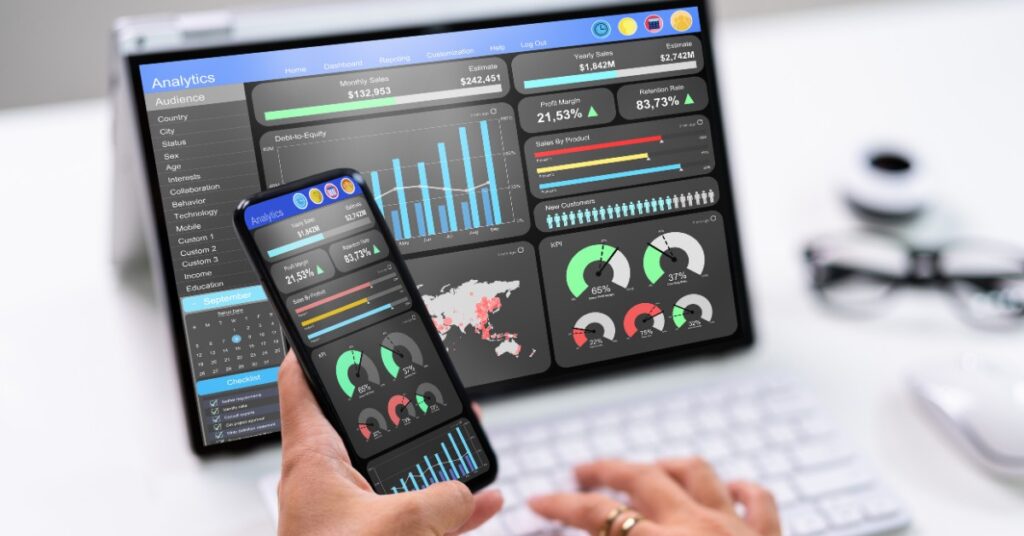Reading Analytics Dashboards to Sell Books

Ask the average person to describe an author’s personality and you’ll likely get a predictable list of adjectives: creative, whimsical, scatterbrained. Talk to the professionals that make up our community, though, and you’ll realise these stereotypes aren’t true. Indeed, while many newbies adopt these limiting descriptions as personality traits, successful authors tend to lead the way by being organised businesspeople. Yes, they’re creative, but they’re also analytical, and they need to be. After all, self-publishing is now the best business model for most serious authors, and being analytical is vital to run a successful publishing operation.
Shedding the harmful belief that you can’t be analytical because you’re creative isn’t easy. That said, it’s necessary if you want to find your own die-hard fans and live off your writing. Nowhere else is this reality more apparent than when it comes to marketing your books. Truly, many authors never experience their dream simply because they say they “don’t do” numbers or understand graphs. Harbouring this belief is understandable if you failed algebra at school. Until you embrace analytics, however, publishing will always feel like building a house of cards in the dark — an activity fraught with short-lived progress and self-inflicted sabotage.
Will all the graphs, acronyms and percentages baffle you at first? That’s possible, but stick with it because once you wrap your head around one dashboard — like the Amazon ads one, for example — the concepts click. Then it’s like turning on a light and spotting a glue gun next to the card deck; you gain clarity, confidence and a framework for making consistent progress. What’s more, as dashboard concepts are largely universal, each new dashboard you encounter will be easier to conquer than the last. To begin, all you need is a basic understanding of the customer journey and guidance on what metrics to monitor at each leg, as you’ll find out in today’s article.
Reader Awareness
An author’s pen name is a brand just like Apple or Marvel, both of which need awareness to survive. This is because awareness leads to activity. It feeds the top of your sales funnel, populating your dashboards with data you can use to analyse and make good decisions. What is the metric of awareness? Impressions. Say you create a piece of content like a paid ad or a social media post and it gets 200 impressions. That means 200 potential readers saw it due to their identity and actions; keywords they typed, products they viewed, interests they expressed. All other metrics spawn from impressions, and the more you generate, the more data you can collect.
Impressions start the data flow but, if nobody clicks on your content, that’s where it stops. They simply register that your brand exists but never buy your products. Combatting this fate requires you to get clicks. General clicks are fine for most dashboards like Google, Amazon or BookBub. Just be aware there are a lot of ways a reader can click Meta content. Thus, “unique outbound link clicks” should take priority on that platform as they show a more accurate picture of how many readers are actually leaving Facebook to follow your sales funnel, be it via a retailer sales page or your website. The more relevant clicks you get, the better you content will perform.
Reader Relevance
Once you’ve got some impressions and clicks, the next thing you need to consider is whether your content is relevant for the audience you’re targeting. Unfortunately, most analytics dashboards don’t offer a quantifiable metric for content relevance. As a result, you need to identify it yourself using two other metrics, the first of which is click-through-rate (CTR). You calculate CTR as follows:
Total Clicks
CTR = —————- × 100
Total Impressions
You present CTR as a percentage. The higher the percentage, the more the audience you’re reaching is clicking your content which, in theory, means they’re a good match. However, that’s not the full picture.
You see, some content generates the wrong sort of clicks. This happens when the funnel behind it doesn’t match the façade. Many ad platforms combat this issue by driving up the cost per click (CPC) of content that causes negative feedback and lowering the CPC for more relevant alternatives. Why bother watching CPC if you can still turn a profit, though? Besides risking wasted spend, such behaviour can lead to a low sales conversion rate which, in turn, discourages recommendation engines from promoting your work on some platforms. Essentially, run irrelevant content and you could miss out on the free revenue of organic reach. So, watch your CTR and CPC.
Reader Engagement
Channelling readers into your sales funnel is all well and good, but are those readers engaged? It’s important to ask yourself this question because disengaged readers do nothing for your brand in terms of sales or referrals. So, what metrics can help you measure reader engagement? That depends on the dashboard. For example, if you’re running a Facebook ad, the number and quality of comments on the ad can be helpful. So can the number and quality of book reviews your content’s generating as readers feed through your funnel. If you’re promoting some content on a site you own, measuring reader dwell time can also act as a litmus test for engagement levels.
If your content generates few positive comments or reviews, or readers quickly leave your landing pages, it’s possible your targeted readers aren’t engaged. What’s the cause? Typically, if you’re getting lots of clicks then the issue is a mismatch between the content you’re pushing on social media, and the content you provide further into your sales funnel, i.e. your books, blog posts or whatever you’re offering. You might have created an ad that seems relevant to readers but underdelivers on the back end. In that case, you should either target different readers or raise your standards on the back end with better copy, images, social proof, or simply a better offer.
Reader Cost
Follow the advice up to this point and you should get relevant brand awareness and an engaged readership, translating to sales, page reads, subscribers or whatever conversion metric you value. Once you’re converting readers, though, next you must ask, “Is the reward worth the cost?” Don’t worry if you’re not sure what it costs you to acquire a reader. You might need to access multiple dashboards and use a calculator, but finding the answer is simple. The equation goes as follows:
Total Costs
———————- = Cost of Reader
Number of Conversions
For example:
$500 Ad Spend
————————– = $20 Cost
25 Conversions
Admittedly, this figure isn’t perfect. For a start, it doesn’t factor in costs like VAT, which may appear on your bill in addition to the “Ad Spend” figure on your dashboard. Nor does it consider the hourly cost of your time and the opportunity cost of producing social media content when you could be writing books. However, it does provide a benchmark you can use to compare campaigns in your dashboard. Sometimes, as soon as this figure appears, you’ll know your operation isn’t sustainable. If that’s the case, you must either reduce costs by finding a more relevant audience or increase your average basket value by raising prices or upselling product bundles.
Reader Value
While profitability will be obvious if you only have one book and practically no organic exposure, reality isn’t always as it seems when you factor in halo sales and long-term reader value. Say, your ads run at a loss but the awareness they generate boosts organic sales. Similarly, imagine you’ve written a long series in which book one is a loss leader. Do ads promoting it still lose money when you factor in readthrough? Suddenly, the value of a reader acquisition doesn’t align with a sale on your dashboard. Calculating three scenarios, though, will give you a deeper understanding:
- The outright value your content generates
- The revenue impact on your wider business
- The lifetime prospects of a conversion
Say $10 daily spend results in two sales or $5 in dashboard revenue. That values an acquired reader at $2.50. Now, look at your baseline revenue. Say it was four sales ($10 a day) before you ran ads but eight sales ($20) after them. Only two sales ($5) appear on your ad dashboard but you’re also generating two extra per day in organic revenue, which values converting a reader at $5. Factor in series readthrough and the value could swell to over $20, meaning you can acquire a reader at a cost of $20 and still break even. The lesson here? Don’t rush to switch off ads when they look unprofitable. A lone analytics dashboard doesn’t always tell the full story.
Understanding how to read an analytics dashboard is a valuable skill that can totally change your author business prospects. As you can probably tell if you’ve made it this far, though, being fluent in analytics won’t guarantee 100% clarity. Marketing is a science of statistics, yes, but it’s also an art with variables that move readers in mysterious ways. So, remember to break down the figures but always have a war chest to cashflow you when what’s worked in the past temporarily stops in the present. Doing so will afford you time to recalibrate, survive a brief drop in income, and maintain control over your author business for the long term.

Daniel Parsons
Dan Parsons is the bestselling author of multiple series. His Creative Business books for authors and other entrepreneurs contains several international bestsellers. Meanwhile, his fantasy and horror series, published under Daniel Parsons, have topped charts around the world and been used to promote a major Hollywood movie. For more information on writing, networking, and building your creative business, check out all of Dan’s non-fiction books here.
Grab Your SPF Freebies!
Sign up to receive your SPF starter package, which includes a free 3 part video series on getting started with FB ads, and inspirational and educational weekly emails.

